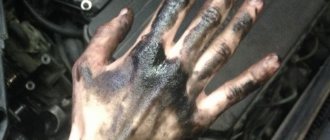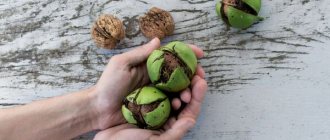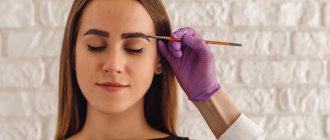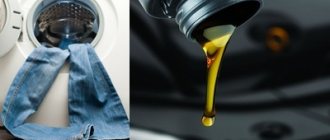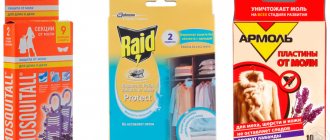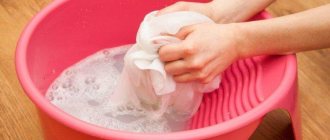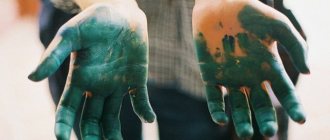In today's publication we will talk about how to wash stains from your hands. Since this product is quite caustic, you may have to use a variety of methods to cleanse the skin. Let's figure out which ingredients are best to use and study effective recipes. Moreover, almost all products can be prepared at home.
Thick wood stain that is difficult to wash Source kupisantehniky.ru
How to remove stain from wood?
You can use a 15% aqueous solution of hydrogen peroxide with the addition of ammonia in such an amount that the composition has a strong smell of ammonia.
Wet the surface of the wood with this mixture and leave it for several days, after which it becomes completely white. After such bleaching, the wood surface does not require any washing.” Look, peroxide can really burn your skin, so only wear rubber gloves. Sold in pharmacies as tablets.
Best regards, Vladislav.
PS. If we are really talking about stain, and not about colored varnish.
| Mosinman |
| xwing |
It won’t remove the stain normally. All this home-grown nonsense like Oven Cleaner or Orange Blast was invented IMHO from excessive stinginess. There is an amazing thing called Wood Bleach, it will return the color one or two times. However, it is more expensive than Oven Cleaner
My thought is that there are good products created for working with wood, there is no need to look for replacements.
| headhunter |
| Kadett |
| Mosinman |
It won’t remove the stain normally. All this home-grown nonsense like Oven Cleaner or Orange Blast was invented IMHO from excessive stinginess. There is an amazing thing called Wood Bleach, it will return the color one or two times. However, it is more expensive than Oven Cleaner
My thought is that there are good products created for working with wood, there is no need to look for replacements.
I wrote – it works, it’s been tested. By me personally. And Wood Bleach is, well, a buck more expensive. It's not about the money. Although, of course, it is correct to use specially designed products for wood. It’s just that the wood on the locker is different from the wood on the butt of a hundred-year-old rifle, since no one has been carrying the locker in their hands all this time. That's why I use Oven Cleaner to remove all the dirt at once.
On the issue of drying oil. Gentlemen, send on. Fuck all these ancient recipes with natural drying oil. Are you going to live forever? Should you dry the wood according to the year? Buy normal bourgeois oils for impregnating wood at a building materials store. Three days and everything is dry and beautiful. You can shoot.
| headhunter |
Drying oil, I suppose, “natural of the highest quality,” from the nearest construction base?
It’s done like this: onto a barrel of synthetic pseudo-drying oil “oxol”, which dries for years, add a bucket of natural oil, bottle it – and off you go! I bought a couple of bottles of oil at an art salon. The oil is liquid - even without boiling down. It took a month and a half to dry to hardness. if drying oil is applied, the alcohol stain will lie unevenly, in spots. water - will not lie down at all. so you have to wash it. perhaps, really - eat. Xia. organic solvent + sawdust + household rubber gloves. Of the solvents, turpentine is the most harmless to wood, although others dissolve faster.
| Antti |
. I bought a couple of bottles of oil at an art salon. The oil is liquid - even without boiling down. It took a month and a half to dry to hardness.
How much is needed for one Tikkov stock? I bought one 100 gram pizirek, and now I’m thinking – isn’t that enough?
| Mosinman |
How much is needed for one Tikkov stock? I bought one 100 gram pizirek, and now I’m thinking – isn’t that enough?
| headhunter |
How much is needed for one Tikkov stock? I bought one 100 gram pizirek, and now I’m thinking – isn’t that enough?
it took one and a half for the “Moose” stock – but it’s birch. like a sponge.
Comments
see also
I'm smart - I sloppily painted the countertop under the sink, thinking that I could easily wipe off the sink itself and the tiles. Nail polish remover helped, but wasn't great. Besides, it's over. The solvent does not take at all, although...
Please advise! The apartment was renovated for four years (in parts). At the very beginning, a new metal door was installed; when purchased, it was covered with a self-adhesive film; of course, they did not remove it. Once the renovation was completed, I began...
Girls, DD. There are chairs made of white leatherette that my son painted with a ballpoint pen. I rubbed everything that was at hand, but the stains were ingrained and did not budge. What other remedy should I try? Soaped with formic alcohol, nail polish remover...
Girls, please advise how I can wipe off the paint if white spirit doesn’t work? The pants are black, the paint is white and very visible. The border paint (my son brought it after a walk on a scooter, and has long since dried (while we bought the solvent, it has almost grown in...
Yesterday an installer came and installed an interior door and accidentally splashed foam, but it doesn’t wipe off the laminated surfaces at all. So, we tell him, wipe off this stain, it’s in the middle of the door and all this...
Girls, help...they are painting benches everywhere now...we painted them green...and they already took off the paper (which had been painted since it had been there for several days, apparently they painted it with cheap, bad paint...if it dries like that), and Sonya plopped down in new blue jeans ..how to wipe off this miracle((...varnish for...
1. Does anyone have any positive experience in assembling an IKEA kitchen on their own?? Is this real? My husband is planning to pack his uncle together, I’m trying to dissuade him, but so far it’s in vain) 2. Owners of acrylic countertops with cast sinks - I read here yesterday...
Kitchen. In the kitchen, everything is always at hand, well, this is understandable, in a 6-meter kitchen, no matter how you turn, everything is still at hand))), I laugh... Well, there’s no escape, what is what is….
How can you really remove masking tape from glass? Before painting the windows I glued it, in short it stuck to the glass like this…. I’ll say right away, Google didn’t help, maybe there is a product that dissolves it... I don’t know 1) I tried white spirit and some kind of solvent, it didn’t help...
In private houses, country houses, and often in apartments, wooden products are used, such as doors, windows, flooring, gazebos, furniture and decorative parts. And no matter how magnificent wood is in its original form, due to the constant influence of external factors and time, it gradually loses its consumer qualities and attractiveness. What to do in such a situation? The answer is very simple: if you want to preserve the natural structure and appearance of wood for many years, stain will help you.
Stain is not paint; it will not hide the texture of the wood (you can see this in the photo)
The easiest way to remove stain from hands, linoleum and plastic
Stain is an excellent wood treatment product. It can breathe new life into old frames, refine furniture, and protect things made from wood from rot. But its significant drawback is the ability to tightly stick to surfaces, eating deeply into them. Let's figure out how to wash stain from your hands, remove stains of this product from clothes, and remove from the floor and furniture.
Video description
How and with what to quickly wash paint, enamel, and primer from your hands.
After such a procedure, it is recommended to avoid contact of the skin with alkalis and acids for some time. Hands need to recover after such aggressive treatment.
Using soda and cola to clean the skin of hands from stain Source fotostrana.ru
What is stain and why is it difficult to clean?
Stain is a wood treatment product. It is also called “beitz” (this term comes from the German word “Beitze”). It gives the wood color and protects against rot, bacteria and mold. Unlike paint, stain does not hide the texture of the wood. The pattern of growth rings after processing stands out brighter, turning into the selected color. This effect is explained by the ability of the stain to penetrate deeply into the structure of the material.
In this ability lies the secret of the extreme “corrosiveness” of stain stains. On many forums there is an opinion that if clothes are damaged by stain, then it is easier to throw them away than to wash them. It is also bad, according to supporters of this point of view, to wash the floor or furniture. At the same time, other users are confident that stains can be removed. You just need to choose the appropriate method.
Preventing stains
It is easier to prevent the appearance of a stain than to later try to wash off the stain from various coatings with unclear results, risking ruining them forever. Therefore, before starting work, carefully consider your protection strategy:
- Cover the floor in the work area with several layers of newspapers.
- Before starting processing, dress in work clothes. Protect your hands with gloves and your hair with a hat.
- Cover the workbench or table on which the item being processed is dried with polyethylene.
Always close the lid of the stain container tightly when taking breaks from working. Analysis of reviews on thematic forums shows that most problems are a consequence of an open can being knocked over due to negligence.
While working, do not throw the brush anywhere, but place it on a prepared tray from which it will not fall out onto the table. And keep a rag handy to wipe off any excess drips from your brush, jar, and workpiece before they hit the floor.
My crazy hands: restoration of an antique sideboard
I’ve almost finished the buffet that was given to me by a friend before Christmas and took up all the vacation days this summer. The buffet was like this:
What did you do? I took it apart. There were only three parts: a lower chest of drawers, an upper display case and two drawers (the crown was missing, and the chisels from the middle part were missing too). Dresser
First I took the bottom part. The top varnish coating was washed off with acetone. At the same time, I made “acetone compresses”: - apply acetone to the surface to be washed off with a brush;
- completely immerse the rag in acetone and lay it out on a surface that has already been coated with a brush; — cover everything with film (bag) so that the acetone does not evaporate;
- We wait a minute or two, we film everything. Ideally, the entire coating comes off with the rag. Like this:
At the same time, the varnish (or whatever was previously smeared there) begins to bubble, burst and slide off:
Wash off the residue with a sponge or rag soaked in acetone:
We clean the threads separately using any scraper. I’ve been using my grandmother’s old manicure tool for the umpteenth time now – it’s very convenient! – and last year’s toothbrush:
Here: one dresser door has been washed, but the other has not yet - what is called “feel the difference”:
Here's a completely cleaned chest of drawers:
When the bottom part was completely washed, I started working on the top. I did everything the same, with the only difference that I first sealed the glass with paper tape (I really didn’t want to bother with cleaning it later), and the top part was covered with white oil paint (that’s where I had to tinker). Here is a general view of the showcase:
The showcase is almost a mummy
Of course, there wasn’t a lot of oil paint, but the fact itself:
Removing white paint with acetone lotions:
The top, due to the presence of a large number of different carvings, was not easy. Everything, literally everything was filled with old coverings! This is the horror:
And this is what the carving looked like after. Beauty!
The crown for this buffet was found in the country stash. Luckily, the size fits perfectly! She suffered the same fate: washing with acetone, with rags and films.
When the entire surface of the buffet was cleaned in this way, I began painting. The sideboard was covered with several layers of tinted acrylic varnish (bought and tinted at Ob; color number - SW133). I applied the varnish with a regular sponge:
I left everything to dry in the sun.
The crown turned out to be painfully good in its painted form:
All the carvings are painted (by the way, I had to get into the most inaccessible places with a thin artistic brush):
I brought it home. I bought and glued new fittings onto the hot gun. Here are the beautiful handles on the sideboard now:
Collected. I arranged my grandmother's crystals. I admire it. Now there is little left. Sharpen the boxes - for some reason they don't fit all the way in - and put them in place. Fit the points on which the upper part should stand, so that a niche is formed between it and the chest of drawers. ps: Keep in mind: all the time you work (from morning to evening, until you are completely done; and for me, by the way, all this work took 12 days!) your hands will look like this and only like this! And no gloves will help! And don’t wash it, and don’t scrape it off :) When the buffet was completely ready, I poured the remaining acetone into a bucket and dipped my hands in them up to the elbows for a few minutes. There was simply no other way to clean them :)
If it does spill, what should you do?
No matter how careful you are, it only takes a few stray drops to create noticeable stains on the floor, furniture or hands. In this case, only quick and correct actions will help.
Analyzing the composition
First of all, we study the label on the jar of the product. Our task is to understand which group the stain belongs to.
- Water-based stains are either dry powders that are diluted with water before use, or ready-made solutions. The chance of washing such a composition from hands, clothes or floors is highest.
- Oil stains are based on drying oil - a fatty substance based on vegetable oil. It has almost no smell, but it dries for quite a long time and is practically insoluble in water.
- Alcohol solutions. This stain is based on denatured alcohol, which evaporates very quickly. Typically, such stains dry out almost instantly, making them difficult to remove.
- Acrylic stains are made from synthetic resins. They dry quickly and successfully resist many solvents. This option inspires the least optimism regarding the possibility of completely removing the stain.
Having figured out the type of stain, it is easier to choose a solvent for removing stains.
Wrong actions only increase the damage. Therefore, it is not recommended to rub the stain, smearing it over the surface. Before cleaning linoleum with a solvent, try it on a small piece in an inconspicuous place to make sure that the caustic liquid does not destroy the top layer of the floor covering. Do not roughly scratch the surface, as it will be difficult to polish the scratches later.
How to remove stain from clothes?
The main task when removing stains from clothes is to wash off the stain without destroying the dyes with which the fabric is painted.
This method of cleaning clothes is recognized as the most effective:
- Dilute oxygen bleach with water (the finished mixture should resemble a thick paste in consistency).
- Apply the gruel to the stain.
- Allow the bleach 20 minutes to break down the stain.
- Wash the item in the washing machine.
Most often, even the use of bleach does not completely eliminate the stain. But it is possible to improve the appearance of clothes.
The traces remaining after staining can sometimes be disguised with decorative stripes, embroidery or a badge.
We wash our hands after work
Removing fighter from your hands is not an easy task. The dye penetrates deeply into the epidermis, and it is often impossible to remove the stain completely. Working with solvents is only allowed with great caution, since alcohol, acetone and other liquids dry out the skin greatly. Often, complete removal of stains occurs only after a few months, when the colored epidermis completely peels off from the hands.
Woodworkers consider the most effective method of removal to be hand washing a small rag (for example, a rag stained with stain) in a stain-removing composition. If the stain is water-based, use water for washing; if it is alcohol-based, use denatured alcohol. The combination of solvent exposure and prolonged friction provides good cleaning.
After you finish washing your hands, treat your skin with a nourishing cream or ointment based on dexpanthenol (“Bepanten”, etc.). This will protect the skin from drying out.
Cleaning linoleum and plastic
Remove stains from plastic or linoleum with acetone. White spirit can also be used. But you need to act carefully. First, the stain is soaked with cotton wool soaked in a solvent, then the top layer is removed. And so on several times until the result is achieved.
It is very difficult to remove stain. Therefore, every effort should be made to protect surfaces that are not planned to be treated from it.
Colored with a felt-tip pen: how to wash clothes
Otherwise, the procedure will need to be repeated. Denatured alcohol is applied to the wet spot treated with solvent.
❶ How to remove nail polish from clothes
